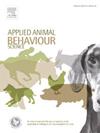Behavioural complexity in fattening pigs I. Video-based validation of a novel welfare indicator according to varying intensity of housing conditions
IF 2.2
2区 农林科学
Q1 AGRICULTURE, DAIRY & ANIMAL SCIENCE
引用次数: 0
Abstract
The interest in individual animal welfare has increased in recent years. One of the reasons is a growing awareness of the importance of animals’ individual differences in their individual capability to adapt to their environment. However, animal- and individual-based welfare indicators are often time-consuming to record and it is challenging to combine several indicators into a meaningful measure for welfare assessment. Behavioural complexity, including previously proposed features (e.g. number of behaviours, Shannon diversity index) as well as new features (e.g. variances of bout durations within and between behavioural transitions), has the theoretical potential to reflect animal welfare in a valid and relatively simple way. For a first practical validation of the complexity measure, 3912 hours of continuous video data from 163 fattening pigs - recorded on 85 days in three age classes, two seasons, and four housing levels of different intensities - were analysed. Twelve complexity-features were reduced using principal component analysis and the resulting principal components (PCs) were analysed using linear mixed effects models. General complexity (PC 1) was on average higher with higher housing levels (p [housing level] = 0.007; p [global] = 0.003). This pattern was modulated by age, with older pigs having a lower general complexity and a more pronounced relationship with housing levels (p [housing level x age class] = 0.009) but not by season (main effect and interactions: p > 0.422). The transition variability (PC 2) was on average also higher with higher housing levels (p [housing level] = 0.008; p [global] = 0.149) and neither age nor season had a statistically supported effect (p > 0.10). The Shannon diversity index for the frequency of behaviours as possible simplified measure showed the same pattern as the general complexity Moreover, this Shannon-diversity index had a more pronounced relationship with housing level in winter than in summer (p [housing level x season] = 0.012). These results suggest, that behavioural complexity could potentially be used as an individual-based indicator to detect changes in animal welfare if measured longitudinal in order to take age and season into account. Further advances in the automated analysis of video data are needed for practical use on farms. Additionally, further studies will need to correlate individual behavioural complexity against other individual measures of welfare.
育肥猪的行为复杂性I.基于视频的新型福利指标验证,根据不同的住房条件强度
近年来,人们对个体动物福利的兴趣有所增加。原因之一是人们越来越认识到动物个体差异在适应环境能力上的重要性。然而,以动物和个人为基础的福利指标的记录往往很耗时,而且很难将几个指标结合成一个有意义的福利评估措施。行为复杂性,包括先前提出的特征(如行为数量,香农多样性指数)以及新特征(如行为转变内和之间的持续时间差异),具有以有效和相对简单的方式反映动物福利的理论潜力。为了对复杂性度量进行首次实际验证,对163头肥猪的3912 小时连续视频数据进行了分析,这些数据记录在85天内,分为三个年龄等级、两个季节和四个不同强度的猪舍水平。利用主成分分析对12个复杂性特征进行约简,并利用线性混合效应模型对得到的主成分进行分析。一般复杂程度(pc1)随居住水平的增加而增加(p[居住水平]= 0.007;P [global] = 0.003)。这种模式受年龄的影响,年龄较大的猪的总体复杂性较低,与猪舍水平的关系更明显(p[猪舍水平x年龄等级]= 0.009),但与季节无关(主要影响和相互作用:p >; 0.422)。住房水平越高,过渡变异性(pc2)平均也越高(p[住房水平]= 0.008;P [global] = 0.149),年龄和季节都没有统计学支持的影响(P >; 0.10)。Shannon多样性指数对于行为频度的尽可能简化度量与一般复杂性表现出相同的模式,并且该Shannon多样性指数与冬季住房水平的关系比夏季更为显著(p[住房水平x季节]= 0.012)。这些结果表明,如果纵向测量以考虑年龄和季节,行为复杂性可能被用作基于个体的指标来检测动物福利的变化。在视频数据的自动分析方面需要进一步的进步才能在农场实际应用。此外,进一步的研究需要将个人行为复杂性与其他个人福利衡量标准联系起来。
本文章由计算机程序翻译,如有差异,请以英文原文为准。
求助全文
约1分钟内获得全文
求助全文
来源期刊

Applied Animal Behaviour Science
农林科学-行为科学
CiteScore
4.40
自引率
21.70%
发文量
191
审稿时长
18.1 weeks
期刊介绍:
This journal publishes relevant information on the behaviour of domesticated and utilized animals.
Topics covered include:
-Behaviour of farm, zoo and laboratory animals in relation to animal management and welfare
-Behaviour of companion animals in relation to behavioural problems, for example, in relation to the training of dogs for different purposes, in relation to behavioural problems
-Studies of the behaviour of wild animals when these studies are relevant from an applied perspective, for example in relation to wildlife management, pest management or nature conservation
-Methodological studies within relevant fields
The principal subjects are farm, companion and laboratory animals, including, of course, poultry. The journal also deals with the following animal subjects:
-Those involved in any farming system, e.g. deer, rabbits and fur-bearing animals
-Those in ANY form of confinement, e.g. zoos, safari parks and other forms of display
-Feral animals, and any animal species which impinge on farming operations, e.g. as causes of loss or damage
-Species used for hunting, recreation etc. may also be considered as acceptable subjects in some instances
-Laboratory animals, if the material relates to their behavioural requirements
 求助内容:
求助内容: 应助结果提醒方式:
应助结果提醒方式:


